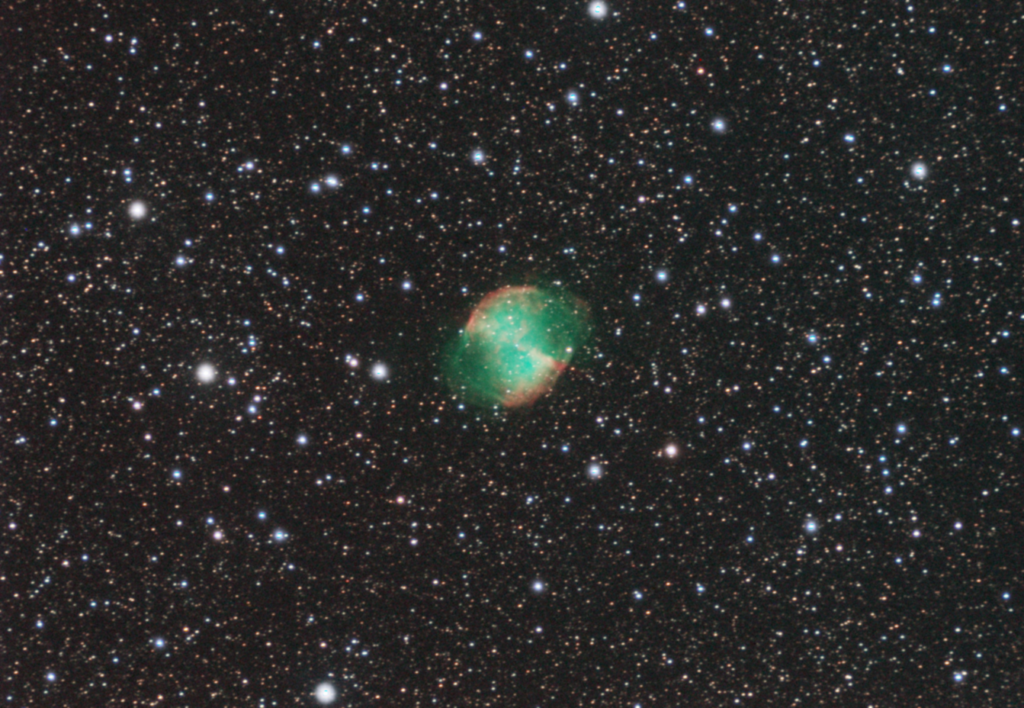M27 Dumbbell Nebula with Atik 314E CCD

The Dumbbell Nebula was discovered in 1764 by famed French astronomer and comet hunter Charles Messier. It is the 27th object in his eponymous catalog, better known as M27.
The hot central star, which can be seen in this image, is in one of its last evolutionary stages. The gases were ejected about 9,800 years ago based on the expansion rate determined by a group of researchers in 1970.
The intense ultraviolet radiation from the central star causes the gas atoms of the nebula to emit light in the visible spectrum. The color of the light is significant. Red indicates hydrogen and green indicates oxygen. M27 is known as an emission nebula for that reason. Another type of nebula is a reflection nebula which only reflects the light of nearby stars.
The color of ionized oxygen is green in my image. Other photos may show it as bluish-green or cyan. The actual color is in indeed cyan. This discrepancy has to do with my camera’s filters. There are many decisions when purchasing filters, chief among them is how they handle ionized oxygen, so-called OIII regions at 501nm wavelength. OIII is right at the dividing line between the green and blue filters. My green filter passes nearly all of the OIII light; relatively little passes through the blue filter. Other manufacturers design their filters to pass equal amounts of OIII in both the green and blue filters, giving you cyan. This highlights the challenges of properly imaging emission nebulae. All other colors are accurate, including star colors.
This image is the first done with my new $400 CCD camera: Atik 314E. It is “new” to me but the camera is actually 10 years old. This is an outstanding price for a quality CCD camera. You can easily spend $2,000 or more for newer CCD cameras.
CCD image quality is superior to CMOS in my opinion. The more experience I gain in astrophotography the more convinced I am that one size does not fit all. Before anything you must answer the question: what is my goal? If your answer is lunar and planetary imaging then CMOS is right for you. If your answer is deep-sky, like nebulae and galaxies, then CCD is the choice.
One closing remark about my image: you may have noticed a faint reddish cast to the leftmost two-thirds of the image. This is not light pollution. It is the Milky Way.
Here are the technical details for those who would like to duplicate my results:
William Optics 71mm f/5.9
Atik 314E CCD (cooled but not set-point)
Optolong LRGB filters
Unitron Model 142 German Equatorial Mount (GEM) — 50 years old.
Tracking: Own design Periodic Error Correction (PEC) using stepper motor and Raspberry Pi.
Flat-fielder: Own design “The Flatinator”
Exposure:
Luminance (binning 1×1): 30x 60s
Red (binning 2×2): 30x 73s
Green (binning 2×2): 30x 45s
Blue (binning 2×2): 30x 61s
Flats: 50 each filter
Darks: 50 each filter
Bias (1×1): 100x 1ms
Bias (2×2): 100x 1ms
Total Integration Time: 120m
Captured with INDI/Ekos running on Raspberry Pi.
Processed in Astro Pixel Processor (APP) and GIMP.
White Balancing using a method described by Al Kelly: “White Balancing RGB Filters with a G2V Star”
Bortle 5 site
Transparency: Above Average
Seeing: Average